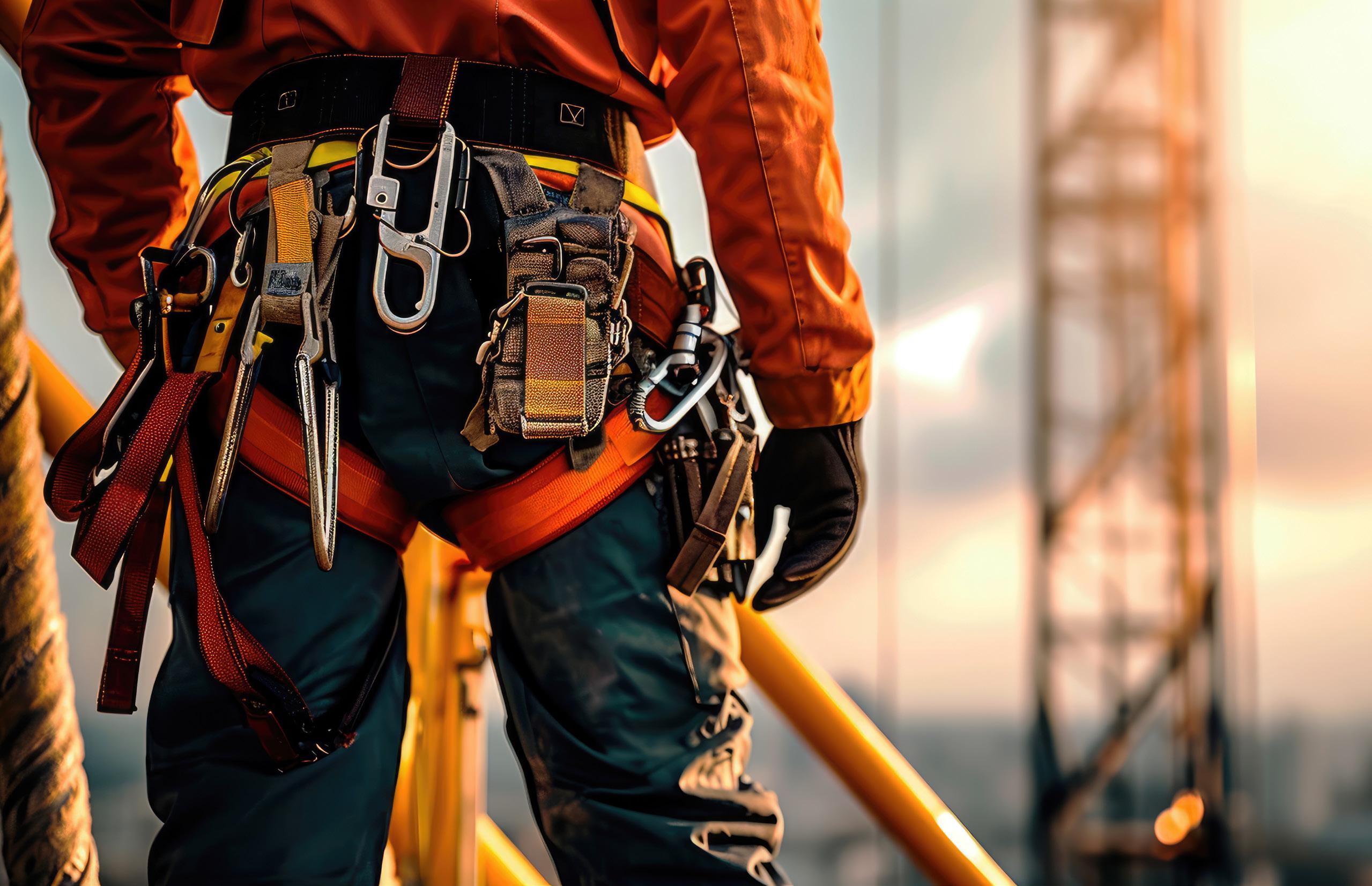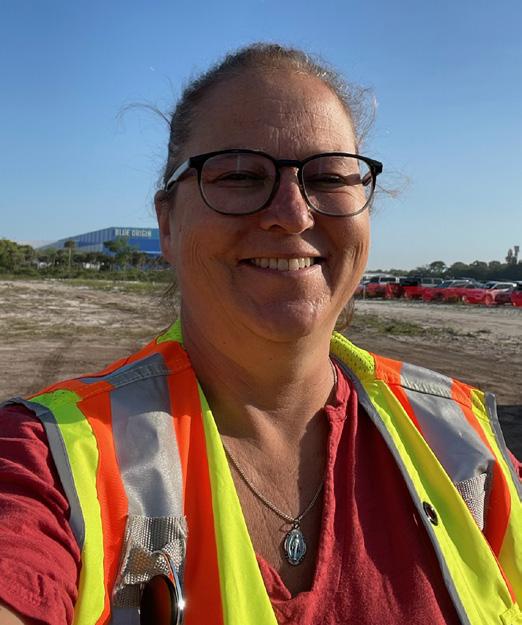THE SAFETY NET

Distracted
IT’S ALWAYS SAFETY FIRST. CONSULT • DESIGN • ENGINEER • CONSTRUCT APRIL 2024 VOLUME 18 ISSUE 04
driving increases the
of
by 23.2
and is responsible
an
of
per
and nearly
a
each
the
is Distracted Driving Month 03.13.24 | Force SAFE T Y FIRST
employees have worked 7,448,096 hours without a Lost Time Accident through 03/2024.
risk
a crash or near-crash
times
for
average
nine deaths
day
half
million injuries
year in
United States. April
Austin

When drivers a vehicles, it’s important that you pay full attention to the road and their surroundings. Even a minor accident can cause big financial setbacks for you or a small business, including the risk of insurance premiums increasing. The average car accident costs a business around $16,500 . The cost increases to $500,000 or more if the crash results in a fatality.
As a business owner, incorporating distracted driving policies into your driver training is imperative. This blog will provide you with actionable tips to ensure your staff don’t drive while distracted.
WHAT IS DISTRACTED DRIVING?
There are three types of distracted driving: visual, manual, and cognitive. Visual distracted driving occurs when the driver’s eyes are focused on something other than the road. Manual distracted driving happens when the driver adjusts, holds, or reaches for something, and cognitive distracted driving is when the driver steers their attention to something other than driving.
Oftentimes, drivers will also try to multi-task while they’re behind the wheel, putting themselves, passengers, other drivers, pedestrians, and cyclists at risk.
WAYS TO PREVENT DISTRACTED DRIVING
1. Eat Beforehand
2. Securely Store Loose Gear And Items
3. Get Everything Setup Before You Go
4. Start the Navigation Beforehand
5. Send Text Messages or Make Phone Calls Before You Go
1. EAT BEFOREHAND
Finding time to eat lunch on busy days can be tough. You may be tempted to eat while driving. During your driver, it is critical that you know that eating while driving is still considered distracted driving.
Drivers should avoid eating while driving at all costs. If you need to eat while driving, you should do so only if you have pulled over and parked in a safe place (e.g. a parking lot).
What About Drinking?
Drinking coffee, water, or any non-alcoholic beverage behind the wheel can be considered distracted driving. If a law enforcement officer determines that a driver was distracted behind the wheel while consuming a beverage, it can result in a ticket. Taking a sip of coffee or water from a beverage container that requires only one hand to maneuver is usually fine, but erring on the side of caution and consuming the beverage before turning on the engine is the safest approach.
2. SECURELY STORE LOOSE GEAR AND ITEMS
If you’ve ever hit the brakes and had something roll out from under the passenger seat, you’ll know that this can be incredibly distracting. Loose items have the tendency to move around in a vehicle if they are not securely stored, sometimes even falling from back seats.
Before you hit the road, they should ensure all loose gear is securely stowed to avoid distractions while they’re operating a company vehicle. Securely store all gear and paperwork before moving. If the trunk is not an option, we recommend storing items in a large duffle or Tupperware container and placing them securely on the floor or seat in the back of the vehicle.
3. GET EVERYTHING SETUP BEFORE YOU GO
When you first get into a vehicle, you should take the time to make the necessary adjustments to suit your own individual driving needs. This is especially important if you don’t use the same vehicle every day.
Taking the time to make the following adjustments will help eliminate distracted driving:
Seats
Adjusting the driver’s seat to be comfortable, upright, and close enough to the steering wheel and brakes is something that should be done before the vehicle is in motion. Making these adjustments while driving is dangerous and takes the driver’s attention off the road.
Headrest
The top of the driver’s seat headrests should be in line with the top of the driver’s ears. Since your drivers are probably all different heights, the headrest will likely need to be adjusted between drivers. Doing so before the vehicle is in drive is the best way to ensure fleet driver safety
Mirrors
Depending on the type of company vehicles you use, mirror adjustments might be done manually or by automated buttons. Adjusting mirrors while driving can distract a driver from the task at hand. Drivers should adjust mirrors as soon as they are done adjusting their seat.
Seat Belt
Seat belts should be free of twists and tangles and at a comfortable shoulder height for the driver. Drivers should click their seat belts in before beginning to drive.
Temperature
Adjusting the temperature might seem like a simple task but it still takes the driver’s eyes and attention off the road.
Audio
While music, podcasts, and talk radio are all excellent ways to make a drive feel shorter and more enjoyable, skipping to the next song or flipping through the channels contributes to distracted driving and should be avoided. Have your drivers make their audio selections well before they step on the gas.
4. START THE NAVIGATION BEFOREHAND
If your team of fleet drivers visit multiple homes or businesses each day, they are likely using a hands-free device such as a GPS unit or cell phone as their navigation system. Drivers should plug in the coordinates of their destination to these electronic devices to plan their route before departure. Operating them while driving may result in a ticket, or take the driver’s attention away from the road, resulting in a collision, injury, or even death.
5. SEND TEXT MESSAGES AND MAKE PHONE CALLS BEFORE YOU GO
Cell phones are the easiest way for drivers to stay connected with your company’s dispatch during operating
hours. It is critical that your drivers do not manipulate their phones while driving since 13% of all fatal crashes involve cell phone use. This means no text messaging, checking emails, making phone calls, etc.
Text Messaging
Checking a text message takes the driver’s eyes off the road for an average of five seconds (4.6 seconds to be exact). After looking at a cell phone, it takes the brain 13 seconds to refocus. Even voice-to-text or voice notes can be counted towards distracted driving since it still requires the device to be in the driver’s hand to execute.
Drivers should send messages before they start driving and avoid checking their phone again until they have reached their destination and turned the vehicle off. A trick to help prevent drivers from texting or checking their phone while driving is to keep the phone in the glove box. That way it is still close enough in case they need it in an emergency. If the driver must check their phone or send a message, they should pull off the road to a safe location before doing so.
Phone Calls
Talking on the phone while driving is still considered distracted driving as it takes the driver’s attention away from the road. If the driver must make phone calls while driving, the phone must be hands-free, voice-activated, and securely fixed—not held in the driver’s hand and not obstructing the driver’s view.
HOW DO I KNOW IF MY DRIVERS ARE DRIVING SAFELY?
Training drivers on the risks of distracted driving and tips to avoid them is the first step in driver safety, but vehicle tracking is the second step. Install a GPS fleet tracking system to your company vehicles in order to truly know if your drivers are driving safely. This allows you to access full driver and vehicle safety data to effectively manage your employees.

3

Quality and Safety represent two critical aspects of an organization, but they are not the same.
• The goal of a quality department is to ensure that an organization’s products or services meet or surpass established standards and customer expectations.
• The goal of workplace safety is to create a secure environment where employees can perform their duties without fear of injury or health hazards.
Depending on how an organization is structured, it might seem like quality and safety are two completely separate goals, or alternatively, the two workplace standards may be operating smoothly as one department. But a more likely scenario is somewhere in the middle.
• Regardless of how the org chart is set up, workplace quality and safety are deeply interconnected, each playing a crucial role in the success and sustainability of any business.
• As an organization grows, the relationship between quality and safety will evolve.
Review this safety topic to learn more about how quality and safety are different but also how they work hand in
hand, enhancing each other to create a more efficient and productive work environment.
Quality is how well a product or service meets what customers need and want. Quality is about giving customers good value and making sure they’re happy with what they get.
• Quality can be checked in different ways, like how well something works, how long it lasts, if it does what it’s supposed to do, and how it looks.
• To ensure quality, organizations must establish quality standards and implement control processes to check and make their products or services better.
• Product safety is an important aspect of quality assurance. Consumers expect products that are safe and reliable.
Safety is primarily focused on making sure everyone on the job stays healthy and safe while meeting production deadlines or providing services to customers.
• Safety is checked by looking at possible dangers, risks, incidents, and compliance with established regulatory standards.
| WeeklySafety.com
Quality vs. Safety : From Checklists to Culture 02.16.2024
• To ensure safety, organizations should be identifying and managing safety hazards and then implementing corrective and preventive actions to minimize or eliminate those risks.
• A more robust safety department may encompass environment, health, and safety (EHS) as it works to protect personnel and the environment from harm. Workplace quality and safety departments often have competing slogans like:
Quality and Safety may assume they should operate on their own especially when other departments like operations, logistics, sales, and product development are also fueling the competition in an effort to be the top priority for a company.
But the truth is, quality and safety (along with production and logistics) should be working together with a focus on continuous improvement, not for one individual department, but for the entire organization.
• A safe work environment has a better chance to foster a sense of security among employees because workers may feel valued and respected if they feel like their company is taking care of them.
• A positive work culture encourages dedication and a high level of workmanship, which is directly linked to the quality of output.
• Employees who take pride in their work are more likely to produce superior results, and adhere to the safety protocols, further reinforcing the cycle of safety and quality.
Quality and safety management in the workplace share many common processes, making them integral to each other’s success.
• Both quality and safety require a risk-based approach, identifying and prioritizing risks to manage them effectively. This involves tracking key metrics to ensure risk controls are working and making adjustments as necessary.
• A focus on quality can enhance safety measures because quality control processes often involve detailed inspections and reviews to identify and correct errors.
• Quality control processes can uncover potential safety hazards, allowing for proactive measures to prevent accidents.
• By integrating quality checks with safety audits, companies can identify areas of improvement more effectively, ensuring that both safety and quality standards are continuously being elevated.
• Documentation is crucial for both quality and safety, involving the creation and maintenance of policies, processes, and incident records in an accessible and manageable system.
• Involving employees in both quality and safety discussions encourages a culture of shared responsibility. Employee feedback can provide practical insights and promote engagement.
Risk assessment, root cause analysis, and corrective and preventative actions are all common and essential parts of both quality and safety management.
• The quality department conducts risk assessments to identify potential issues in product design or manufacturing processes that could impact product quality, while the safety department performs risk assessments to spot hazards that could cause accidents or health issues for employees.
• Both departments use root cause analysis to dig deep into incidents or non-conformities. The quality department focuses on product or service failures, while the safety department investigates on-the-job incidents.
• The quality department implements corrective actions to fix identified quality issues, ensuring products or services meet the required standards. The safety department takes corrective actions to remove or reduce workplace hazards, protecting employees and the environment.
• In quality management, preventative actions involve adjusting processes and systems in advance to avoid potential quality failures. For safety, preventative actions might include implementing new safety protocols or training programs to prevent future incidents.
• Both departments often collaborate on investigations and solutions, especially when issues overlap between quality and safety, ensuring a comprehensive management of risks.
5

‘Listen to Understand’: DOL Hosts Conversation on Gender-Based Violence in Construction
01.22.2024 | Family Safety and Health
The worst part of Shamaiah Turner’s job as a sheet metal worker hasn’t been the physical aspects, but instead “working with people who made me feel socially unsafe.”
During her 12 years in the construction industry, Turner has lifted heavy materials, worked regularly at height and run heavy machinery – all without a problem, she says.
“Construction is inherently dangerous, so if I’m walking around having to consider other hostile co-workers or having to ward off the person that’s been hitting on me, then my attention is divided. That leaves me and a lot of other people vulnerable.”
Turner was a guest during a March 5 webinar on genderbased violence and harassment in the construction industry, hosted by the Department of Labor Women’s Bureau and OSHA.
Women’s Bureau Director Wendy Chun-Hoon noted that a male-dominated culture in construction can create greater risks for gender-based violence and harassment, which is “a range of unacceptable behaviors, practices or threats directed at persons because of their sex or gender.”
Such behaviors can include sexual harassment, domestic violence, bullying, dating violence, stalking, trafficking, threats, manipulation and coercion. Any of these can create a major barrier to recruitment and retention in construction, Chun-Hoon said.
“Making our workplaces safer is really everyone’s job,” she added.
Alison Stanton, vice president of community and citizenship at Turner Construction in Boston, emphasized that safety professionals and leaders in construction must make a sincere effort to understand the issues workers are facing. “The most important thing that everyone can do is listen,” Stanton said. “From your own chair, listen to understand what some of these experiences are that tradeswomen are going through and try to act from where you sit in order to help them and support them.”
Amy James Neel spent more than 25 years as a carpenter and now serves as workforce and contracting equity manager in the planning and capital construction department at Portland Community College in Oregon.

“Making our workplaces safer is really everyone’s job,”

“I loved being a carpenter,” Neel said. “What I did not love was people’s behavior.” This included bullying, hazing, exclusion and isolation. “These are behaviors that have no place in a professional environment.”
In her current role, Neel said leaders of construction projects at the college ensure psychological safety is just as important as physical safety and include trainings, toolbox talks and repercussions for violations.
“Workers under duress are not safe,” she said. “Addressing incivility becomes the standard and is replicable the same way physical safety is.”
Turner credited her labor union – the International Association of Sheet Metal, Air, Rail and Transportation Workers – for promoting mentorship and solidarity across its membership with the “I Got Your Back” campaign ; gender-neutral language in its constitution; strong penalties for bullying, harassment and hazing; and numerous resources to help recruit, retain and advance women and other underrepresented groups.
“They really stepped up,” she said. “I know that having a large network of support is what saved me.”
7

Get Ready for the National Safety Stand-Down to Prevent Falls in Construction
02.16.2024 | Safety & Health
OSHA is encouraging employers to take a break and raise awareness of fall hazards and the importance of fall protection during the National Safety Stand-Down to Prevent Falls in Construction .
This year’s event is set for May 6-10. Falls from elevation accounted for 395 of the nearly 1,100 construction deaths in 2022, according to the Bureau of Labor Statistics.
Employers and workers can take part in activities such as toolbox talks, safety equipment inspections, rescue plan development or in-depth discussions on hazardous tasks.
Meanwhile, employers whose workers aren’t exposed to fall hazards can “use this opportunity to have a conversation with employees about the other job hazards they face, protective methods, and the company’s safety policies and goals,” OSHA says. “It can also be an opportunity for employees to talk to management about fall and other job hazards they see.”
Resources include suggestions to prepare for a successful stand-down and highlights from past events. A webpage lists events that are free and open to the public to help employers and workers find events near them.
Employers can download a certification of participation after the stand-down and share their activities on social media using the hashtag #StandDown4Safety.
OSHA initiated a National Emphasis Program on falls in May and hosted a webinar titled “Preventing Falls Through Improved Design” in March 2023.

Long Covid is Showing Up in Medical Claims
08.21.2023 | EHS Today
“At an average of 18 months of post-infection experience, these workers received more than 20 weeks of temporary disability benefits and received about $29,000 in medical care,” a new study finds.
A year after contracting COVID-19, 6% of workers were still receiving medical care due to the effects of long-term COVID, according to a new study from Workers Compensation Research Institute (WCRI).
This study expands prior evidence from early in the pandemic, showing persistent rates of long COVID infections through 2021.
“Our main takeaways for workers’ compensation policymakers and stakeholders are that long COVID continued to affect a meaningful share of workers with COVID-19 infections, and that was an important driver of claim costs,” said Ramona Tanabe, CEO of WCRI, in a statement. “At an average of 18 months of post-infection experience, these workers received more than 20 weeks of temporary disability benefits and received about $29,000 in medical care.”
The study, Long COVID in the Workers’ Compensation System in 2020 and 2021 , provides insights into workers’ recoveries from COVID-19. The study addresses the following questions:
• What is the prevalence of long COVID among workers with COVID-19?
• What are the costs of long COVID claims?
• What is the duration of temporary disability benefits among workers with long COVID?
• What are the industry and worker characteristics associated with long COVID?
• How do rates of long COVID vary across states?
The analysis includes COVID-19 cases reported with a date of infection between March 2020 and September 2021. For each claim, we collected information on medical care and income benefits that were provided through the end of March 2022, across 31 states.
9
When End-of-Shif Means End-of-Life
02.23.2024 | EHS Today
Millions of people worldwide are dying on the job every year, and it’s only getting worse.
The U.S. Government, whatever else you want to say about it, does a pretty good job keeping track of work-related accidents and fatalities. We know, for instance, that transportation incidents account for more than a third (37.7%) of all occupational fatalities. We also know that year after year after year, the most frequent OSHA violation by U.S. companies is fall protection, and in 2022 the number of work-related fatalities due to slips, trips and falls increased 1.8%.
And we are also aware of another uncomfortable statistic, provided by the US Bureau of Labor Statistics: A worker died every 96 minutes from a work-related injury in 2022, which is five minutes worse than the average of 101 minutes in 2021. All told, there were 5,486 fatal work injuries in the U.S. in 2022, a 5.7% increase from 5,190 in 2021.
There’s no good news in any of those numbers, other than maybe comparing the lot of U.S. workers with the rest of the world. Every day, on the average, more than 8,000 people worldwide die due to work-related accidents or diseases. That comes to nearly 3 million workers dying every year, either on the job or as a result of some sort of incident at the worksite, according to statistics compiled by the United Nations’ International Labour Organization (ILO). In other words, the number of workers who die every single day throughout the world is more than the number of U.S. workers who die in an entire year.
How is it even remotely possible that in the year 2024, with all the technology and resources and information that’s available on workplace safety, and with companies constantly proclaiming “safety first” slogans, so many people are not going home at the end of their shifts?

A recent report from the ILO—A Call for Safer and Healthier Working Environments—goes into detail about the many causes and conditions that are putting workers at risk throughout the world:
• Nearly 7% (6.71%) of all deaths in the world are workrelated fatalities. The percentage is highest on the African continent (7.39%), followed by Asia/Pacific (7.13%).
• The majority of the work-related fatalities (roughly 75%) occur due to diseases contracted on the job, such as circulatory diseases, malignant tumors and respiratory diseases.
• The number one occupational risk factor contributing to deaths is exposure to long working hours. (Before you scoff at that point and think, “Hard work never killed anybody,” keep in mind that the ILO’s definition of long working hours equates to more than 55 hours per week.) The number two risk factor is exposure to deadly particulates, gases and fumes.
If you’re looking for the slightest sign of something positive in these numbers, the ILO notes that deaths due to exposure to particulates, gases and fumes have dropped by 20% over the past two decades. However, mesothelioma attributable to asbestos exposure is up by 40%, and lung cancers and other respiratory diseases caused by exposure to chromium has doubled over a comparable period. But however you look at the data, it becomes quite clear that workers are dying on the job in horrific numbers, and these can’t be explained away as tragicbut-unavoidable accidents.

Recognizing that things are just getting worse, in late 2023 the ILO launched an initiative called the Global Strategy on Occupational Safety and Health for 2024-2030. One of the goals of this plan (besides the obvious one of reducing workplace accidents and fatalities) is to promote the use of safety management systems by adopting ILO-OSH 2001 principles, a global standard similar to the ISO 45001 standard. (In the U.S., OSHA is likewise encouraging SMS adoption and use.)
The goals of these efforts are quite lofty, and it’s unclear as to how exactly the 187 member states (i.e., countries) of the ILO will cooperate in establishing a common global benchmark for workplace safety. Cultural and geopolitical differences aside, getting nearly 200 countries to agree on anything, let alone how to protect workers in every type of work situation imaginable, is going to take some doing. But acknowledging the problem is at least indicative of a desire to do something about it.
The reality is, technology alone isn’t going to be a gamechanger. Safety management systems, AI-based predictive software, virtual reality training devices, wearable health monitors, smart sensors, warehouse robots, exoskeletons— the list of high-tech safety solutions is long and impressive, but they’re not the be-all and end-all of safety. The real game-changer is the insistence that every workplace fosters a culture of safety. No ifs, ands or buts about it.
11


TACK Builders Inc. and Austin Irvine Office - FirstAid-CPR-AED Training OSHA 30 Hour With TACK Builders Inc.
First Aid - Energy Wheel Training at Leo, SAMT, Blue Origin
On March 12 and 13 American Red Cross First Aid/CPR/AED along with the Energy Wheel safety program from the University of Colorado was presented to the Blue Origin, L3 Harris Leo and SAMT project field employees. I enjoyed giving the training and spending time with the team.



Women In Construction Week
Mia Zicolello requested an Austin hard hat and a safety “Yellow” vest for Woman in Construction week. She is now ready to visit her first project.
Women In Construction takes place during the first full week of March each year. The Austin Company welcomes and encourages women to seek all positions in the design, engineering and construction management role.


 From Left: John Czagas, Jose Socias Russ Kussack, John M. Bueno, Greg Hayes, and Matt Luckett. Rene Seeley
Anne Burns
From Left: Eric Krulisky, Lewis Roberson, Tommy Vega, Jeremy Rentschler, Nick Choppe, Leon Walker, and Kevin Phillips.
From Left: John Czagas, Jose Socias Russ Kussack, John M. Bueno, Greg Hayes, and Matt Luckett. Rene Seeley
Anne Burns
From Left: Eric Krulisky, Lewis Roberson, Tommy Vega, Jeremy Rentschler, Nick Choppe, Leon Walker, and Kevin Phillips.
13
Pictures not shown. Olga Larina, and Taylor Lunsford.

Work Safety Tips: 5 Tactics to Build Employee Engagement for Workplace Safety
03.13.2024 | EHS Today
Employee safety engagement strategies have become increasingly key to fostering a safer workplace environment. But, how exactly do you encourage employee buy-in when it comes to creating a safer workplace? In this blog, we’ll highlight 5 proven work safety tips that managers and leaders can incorporate into their safety culture strategy and operations to achieve a safer workplace.
5 WORK SAFETY TIPS TO PROMOTE STRONG EMPLOYEE ENGAGEMENT
1. GIVE YOUR WORKERS A VOICE
This simple step is one of the most effective ways to promote employee engagement. After all, your employees (especially those who work on the frontlines) are usually the most knowledgeable about the common risks present in their work environment, as well as the ways to control or prevent them. Hearing their feedback, ideas, and opinions allows you to develop a well-rounded, effective safety strategy that employees will want to follow. It is especially important to include frontline workers in conversations
about health and safety strategies from the start, as this can significantly affect future buy-in and engagement in a positive way.
While safety meetings are a great avenue to gather this feedback, you might also want to consider investing in Environmental Health & Safety (EHS) mobility software This ensures you’re able to connect with all corners of your organization quickly and reliably.
Interested in learning more about building employee engagement? Download Cority’s eBook, Light the Fire Within: How to Build Stronger Employee Engagement for Safety
2. TRUST YOUR PEOPLE TO DO THE RIGHT (AND SAFE) THING
Executive leaders that trust their workforce to make safe choices when confronted with risk will leave their employees feeling empowered in their duties. Otherwise, daily functions can become stalled if employees feel like they must wait for instruction before moving forward with tasks that contain some element of risk. By establishing


clear, simple guidelines, you can build greater safety ownership within your workforce and show who needs to know which issues. Mobile EHS apps offer users the ability to access and view these guidelines and instructions wherever they might be, which can be helpful when it comes to addressing safety or risk concerns as soon as possible.
3. ACT ON THE SAFETY FEEDBACK YOU RECEIVE
After your employees give feedback, it’s vital that you not only take it in but make changes based on it. If you don’t use the feedback you get, employees might begin to wonder why they should even give it in the first place. And if leaders don’t know about the problems their employees are facing, they can’t make the changes or provide the resources needed to promote a safer work environment. Creating transparency about these changes is just as important and lets employees know their concerns aren’t being tossed aside. Once again, EHS software and mobile apps allow employees to easily track this progress based on key indicators and metrics.
4. PROVIDE WORKERS WITH THE RIGHT DATA TO MAKE SAFE DECISIONS
Safer work comes, in part, from ensuring that workers have reliable access to the information they need to plan and carry out their tasks. Digital tools like EHS mobile apps will provide your employees with real-time information
about certain risks so they can adjust their work plans accordingly. Employees can also digitally complete checklists and forms to gain authorization from supervisors, even if they aren’t on-site, ensuring that everyone has all the information they need.
5. CREATING A PSYCHOLOGICALLY SAFE WORKPLACE
Workers need to feel like they can be vulnerable with their peers and managers. This means being able to speak openly about mistakes or failures without fear of unjust repercussions. Make sure your organization sets the tone that it’s not just ok, but welcome to admit failures so that you can figure out where improvements can be made. One way you can help to support this work is to utilize the leading indicator metrics in your EHS software to show what helps to proactively manage safety rather than focusing too heavily on lagging indicators.
LEARN MORE ABOUT IMPROVING EMPLOYEE ENGAGEMENT
While there’s no silver bullet to immediately improve employee engagement, taking even just one of these work safety tips can go a long way toward pushing your organization in the right direction. Technology is a great resource in helping promote these changes and keep employees safe.
15

Tools to Help Address Worker Fatigue
03.13.2024 | EHS Today
NSC provides toolkit with cost calculators and assessments to address this issue.
TOOLS TO HELP ADDRESS WORKER FATIGUE
A study from the National Safety Council found that 13% of workplace injuries are attributed to fatigue.
And 43% of American workers say they sometimes are too tired to function safely at their job.
The cost of this was $136 billion annually in health-related lost productivity.
WORKERS WHO ARE FATIGUED MIGHT EXHIBIT NEGATIVE EFFECTS OF FATIGUE, SUCH AS:
• Lacking energy to do their jobs safely or effectively.
• Having trouble paying attention or taking longer to react to what happens around them.
• Taking more risks that may lead to errors or injuries. NIOSH notes that “researchers estimate that close to 1 in 8 of all workplace injuries may relate to fatigue.”
FACTORS THAT CONTRIBUTE TO FATIGUE INCLUDE:
• Performing prolonged physically or mentally demanding tasks.
• Following repetitive routines.
• Working in extreme temperatures.
• Feeling stress.
To help companies NSC has put together a comprehensive toolkit.
HERE ARE SOME OF THE COMPONENTS.
• Fatigue Cost Calculator
• Fatigue in the Workplace: Causes and Consequences
• Fatigue in Safety-Critical Industries
• Fatigue in the Workplace: Causes and Consequences
• Fatigue in Safety-critical Industries
HERE ARE SOME ASSESSMENTS
• Operational Fatigue Risk and Needs Assessment
• Signs and Symptoms Checklist
• Incident Report Questions
• The Role of Fatigue in Motor Vehicle Crashes



















 From Left: John Czagas, Jose Socias Russ Kussack, John M. Bueno, Greg Hayes, and Matt Luckett. Rene Seeley
Anne Burns
From Left: Eric Krulisky, Lewis Roberson, Tommy Vega, Jeremy Rentschler, Nick Choppe, Leon Walker, and Kevin Phillips.
From Left: John Czagas, Jose Socias Russ Kussack, John M. Bueno, Greg Hayes, and Matt Luckett. Rene Seeley
Anne Burns
From Left: Eric Krulisky, Lewis Roberson, Tommy Vega, Jeremy Rentschler, Nick Choppe, Leon Walker, and Kevin Phillips.



